December 6, 1917 the largest man-made explosion in the history of the world devastated Halifax NS
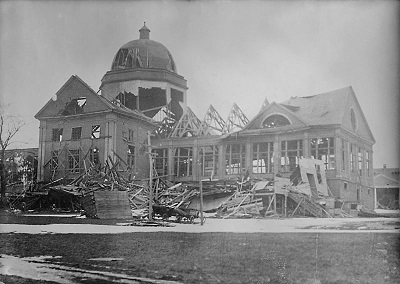
Church destroyed in Halifax Explosion December 6, 1917 where the last body was found. (US Library of Congress)
On December 6, 1917 the largest man-made explosion in history destroyed one-third of Halifax NS.
2,000 people died and another 10,000 were injured.
The North End and waterfront of Halifax were destroyed in an instant at 9:04 AM.
I wasn’t alive during the explosion but I have a pretty amazing Halifax Explosion story nonetheless.
Halifax has been a naval port for the British and then Canadian navy since the city was founded in the 1749. During the Revolutionary War, the War of 1812 and the Civil War, Halifax was busy supplying the goods of war.
During World War I, convoys left Halifax for England with troops and supplies. Vast numbers of ships were anchored in the large Bedford Basin and would pass through The Narrows in the harbor on their way out to the Atlantic.
A French munitions ship, the Mont Blanc, was sailing into the basin first thing in the morning. She was loaded with 24 tons of TNT, picric acid and benzol.
Leaving Halifax for Europe was the Imo, a Norwegian provision ship in a hurry. The Imo’s captain was in the wrong lane, to the Dartmouth side of the harbor, the exact lane that the Mont Blanc would have used. Both captains insisted they were in right of way and the ships collided at 8:40 AM.
When the Mont Blanc went afire, the captain and crew abandoned ship without raising any warning. The people on shore watched the fireworks of the benzol barrels exploding in amazement. Many of them died along with the crew of the Imo when at 9:04 AM the heat from the fire exploded the TNT.
There was a shock wave and tsunami that wiped everything in its path.
“A resulting cloud of white smoke rose to over 20,000 ft. The shock wave from the blast traveled through the earth at nearly 23 times the speed of sound and was felt as far away as Cape Breton and Prince Edward Island.”
“An area over 400 acres was completely destroyed by the explosion, while the harbor floor was momentarily exposed by the volume of water that vaporized. A tsunami was formed by water surging in to fill the void, which rose up as high as 60 ft above the harbor’s high-water mark on the Halifax side.” Wikiepedia
My father told me the tsunami lifted a man from Water Street and deposited him on the roof of a building. He died.
Houses and buildings were little sticks of wood and rubble in seconds. Fires started all over the city with very little that anyone could do. 12,000 buildings were destroyed.
That night the temperature dropped to below freezing and it snowed. Many people who were only injured died from exposure.
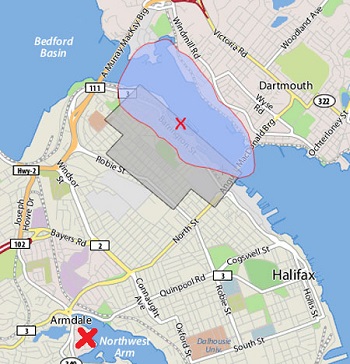
Map of Halifax Explosion showing location of ships, area affected by the blast and Armdale resting place for Mont Blanc anchor (red X) (map Halifax Explosion.org)
The hull of the Mont Blanc was hurled 980 feet into the air, that is the part of the hull that was not converted to molten metal raining down on Halifax.
The Mont Blanc’s anchor shaft was blown 2 miles across Halifax to land on the other side of the North West Arm in Armdale.
A gun from the Mont Blanc flew 3.5 miles away to land near Albro Lake Dartmouth.
For more details check out Wikipedia, Halifax Explosion.org and the NS Archives.
Or check out the movie about the explosion Shattered City: The Halifax Explosion.
My Halifax Explosion Story
No I was not alive during the explosion but when I was 8 we moved to Armdale Nova Scotia, to Edmonds Grounds.
There in a field beside our house was the anchor from the Mont Blanc.
In the picture the anchor was on rocks without any plaque to tell people what it meant.
By the time I arrived it was on a cement slab that made first base for our scrub baseball diamond.
You had to land carefully on first or it could hurt.
No one thought it was special, just the old anchor from the Explosion.
One day I asked the caretaker Mr Clary Edmonds, who was almost 90 years old by that time, if he remembered the Halifax Explosion.
“Yes,” he said softly. He was working that day and when he came home everything was a mess.
A horse-drawn wagon with a driver drove in from Armshore Drive and into Edmonds Grounds and out the lane to Purcell’s Cove Road. The wagon was carrying dead bodies from the Explosion.
Then it came in again and went out the same way in a circle.
After the wagon had gone around in a circle several times, someone stopped it. The driver was dead, killed by the metal from the Mont Blanc that rained down on Halifax.
When I lived there the metal was in the soil and dirt everywhere. It looked like it had been boiled and some part smooth and round and other parts jagged.
I can remember cutting my hands when I fell down, from the metal in the ground.
Today, Edmonds Grounds is gone. They developed it into Spinnaker’s Drive but the anchor is still there, mounted on a pedestal.
The spot is an official Historic Place of Canada. They even have a nice little write-up about the anchor shaft and Edmonds Grounds.
They don’t tell you about our first base or old Mr.Edmonds. And they moved it from the first place it landed from the sky, first base.

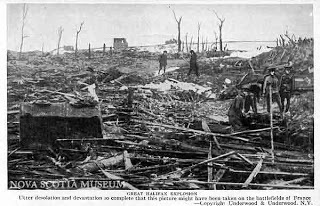
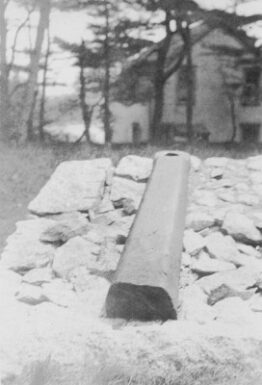
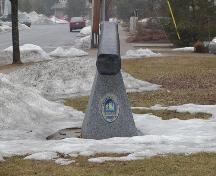
Be the first to comment